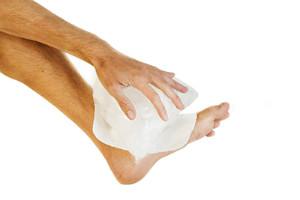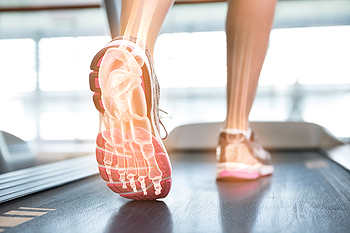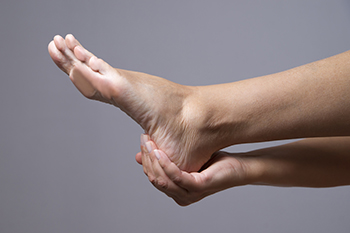(410) 764-7044
6506 Reisterstown Road, Baltimore
1205 York Road, Lutherville
6305 Belair Road, Baltimore
7809 Wise Avenue, Dundalk
December 2022
Various Reasons for Foot Pain

There are numerous tendons, muscles, ligaments, and bones that are in each foot, and enduring an injury can cause foot pain. Discomfort that is felt on top of the foot may indicate that a stress fracture has occurred, or it may be gout, an arthritic condition. Additionally, It may indicate a bone infection has developed, which is known as osteomyelitis. These can be serious conditions, and it is suggested that a medical professional be consulted for evaluation and treatment. Some patients have foot pain as a result of the shoes that are worn, or from improperly warming up and cooling down before and after running. It is important for people who participate in sporting activities to increase speed and distance gradually, and this can allow the feet to become stronger. Foot pain can happen from falling, and practicing fall prevention techniques may help to prevent this. If you have foot pain for any reason, please contact a podiatrist who can effectively diagnose and treat foot and ankle pain.
Foot Pain
Foot pain can be extremely painful and debilitating. If you have a foot pain, consult with one of our podiatrists from Plaza Podiatry. Our doctors will assess your condition and provide you with quality foot and ankle treatment.
Causes
Foot pain is a very broad condition that could be caused by one or more ailments. The most common include:
- Bunions
- Hammertoes
- Plantar Fasciitis
- Bone Spurs
- Corns
- Tarsal Tunnel Syndrome
- Ingrown Toenails
- Arthritis (such as Gout, Rheumatoid, and Osteoarthritis)
- Flat Feet
- Injury (from stress fractures, broken toe, foot, ankle, Achilles tendon ruptures, and sprains)
- And more
Diagnosis
To figure out the cause of foot pain, podiatrists utilize several different methods. This can range from simple visual inspections and sensation tests to X-rays and MRI scans. Prior medical history, family medical history, and any recent physical traumatic events will all be taken into consideration for a proper diagnosis.
Treatment
Treatment depends upon the cause of the foot pain. Whether it is resting, staying off the foot, or having surgery; podiatrists have a number of treatment options available for foot pain.
If you have any questions, please feel free to contact our offices located in Baltimore, Lutherville, and Dundalk, MD . We offer the newest diagnostic and treatment technologies for all your foot care needs.
Foods to Eat or Not Eat With a Broken Toe

A broken toe can be painful, annoying, and often causes difficulty in completing daily activities. It can happen if a heavy object drops on it, or if it is stubbed against a piece of furniture. There are various treatments for a broken toe, and a popular one for mildly fractured toes is known as the buddy taping method. This is done by taping the affected toe to the toe next to it, which can provide adequate support as the healing process occurs. Holistic options can include applying specific kinds of essential oils several times per day, which may accelerate the recovery time. Research has shown that it may be beneficial to include certain types of foods as part of daily eating habits, consisting of salmon, sea vegetables, pumpkin seeds, beef, and spinach. These foods are known for their calcium and zinc properties, which may help to support healthy bone growth. It is beneficial to avoid foods such as refined sugars, soda, and caffeine. If you have broken your toe, please consult with a podiatrist who can guide you towards a healthy and speedy recovery.
A broken toe can be very painful and lead to complications if not properly fixed. If you have any concerns about your feet, contact one of our podiatrists from Plaza Podiatry. Our doctors will treat your foot and ankle needs.
What to Know About a Broken Toe
Although most people try to avoid foot trauma such as banging, stubbing, or dropping heavy objects on their feet, the unfortunate fact is that it is a common occurrence. Given the fact that toes are positioned in front of the feet, they typically sustain the brunt of such trauma. When trauma occurs to a toe, the result can be a painful break (fracture).
Symptoms of a Broken Toe
- Throbbing pain
- Swelling
- Bruising on the skin and toenail
- The inability to move the toe
- Toe appears crooked or disfigured
- Tingling or numbness in the toe
Generally, it is best to stay off of the injured toe with the affected foot elevated.
Severe toe fractures may be treated with a splint, cast, and in some cases, minor surgery. Due to its position and the pressure it endures with daily activity, future complications can occur if the big toe is not properly treated.
If you have any questions please feel free to contact our offices located in Baltimore, Lutherville, and Dundalk, MD . We offer the newest diagnostic and treatment technologies for all your foot and ankle needs.
Are Running Shoes Ok for Walking?

People who walk for exercise often opt for running shoes because of the cushion and support they provide for high-impact activity. However, when choosing running shoes for walking, it is important to pay attention to specialized shoes that would not be appropriate, such as shoes for race running or a running gait. Thinking about the typical terrain of walks should factor into shoe selection as well. Stability is more important in running shoes for secure walking. Most running shoes are made for pavement, but if walking is done on trails or off concrete, walking shoes may be a better choice. Trying on different brands and styles of shoes is recommended. Shoes that allow for a little room between the toes and the end of the shoe or allow for the natural swelling of feet as the day goes on are important. The ultimate shoe should also breathe well for coolness, and improve cracked heels. Professional treatment from a podiatrist is highly recommended. This is especially important if one has diabetes. Those with diabetes often have neuropathy in their feet making it hard to feel important sensations, such as pain from cuts or sores. Shoe selection is a personal decision and comfort should be the top priority. If you would like more information on the type of shoe you should consider for the activities you do, consult with a podiatrist.
For more information about walking shoes versus running shoes, consult with one of our podiatrists from Plaza Podiatry. Our doctors can measure your feet to determine what your needs are and help you find an appropriate pair of footwear.
Foot Health: The Differences between Walking & Running Shoes
There are great ways to stay in shape: running and walking are two great exercises to a healthy lifestyle. It is important to know that running shoes and walking shoes are not interchangeable. There is a key difference on how the feet hit the ground when someone is running or walking. This is why one should be aware that a shoe is designed differently for each activity.
You may be asking yourself what the real differences are between walking and running shoes and the answers may shock you.
Differences
Walking doesn’t involve as much stress or impact on the feet as running does. However, this doesn’t mean that you should be any less prepared. When you’re walking, you land on your heels and have your foot roll forward. This rolling motion requires additional support to the feet.
Flexibility – Walking shoes are designed to have soft, flexible soles. This allows the walker to push off easily with each step.
If you have any questions, please feel free to contact our offices located in Baltimore, Lutherville, and Dundalk, MD . We offer the newest diagnostic and treatment technologies for all your foot care needs.
Plantar Warts Can Be Treated!
All About the Arches of the Feet

The arches of the feet work as a spring that bears the weight of your body whenever you take a step. Most people are familiar with the arch on the inner sole of the midfoot. However, three separate arches combine to form a triangle in the feet that absorb the shock of walking and running. There are two longitudinal arches, medial and lateral, that run along either side of the foot from the heel to the top of the 1st and 5th metatarsal. Plus there is a transverse arch that runs across the midfoot, connecting the tops of the metatarsals. These three arches are supported by a number of ligaments, muscles, tendons, and bones that all help to support the weight of the body. When the medial longitudinal arch is too high, it causes a condition called pes cavus, which can be painful and cause gait problems. When the longitudinal arches collapse, it results in flat feet, known as pes planus. Both conditions, which can affect the way you carry out your daily activities, can be diagnosed and treated by a podiatrist.
If you have any concerns about your feet, contact one of our podiatrists from Plaza Podiatry. Our doctors can provide the care you need to keep you pain-free and on your feet.
Biomechanics in Podiatry
Podiatric biomechanics is a particular sector of specialty podiatry with licensed practitioners who are trained to diagnose and treat conditions affecting the foot, ankle and lower leg. Biomechanics deals with the forces that act against the body, causing an interference with the biological structures. It focuses on the movement of the ankle, the foot and the forces that interact with them.
A History of Biomechanics
- Biomechanics dates back to the BC era in Egypt where evidence of professional foot care has been recorded.
- In 1974, biomechanics gained a higher profile from the studies of Merton Root, who claimed that by changing or controlling the forces between the ankle and the foot, corrections or conditions could be implemented to gain strength and coordination in the area.
Modern technological improvements are based on past theories and therapeutic processes that provide a better understanding of podiatric concepts for biomechanics. Computers can provide accurate information about the forces and patterns of the feet and lower legs.
Understanding biomechanics of the feet can help improve and eliminate pain, stopping further stress to the foot.
If you have any questions please feel free to contact our offices located in Baltimore, Lutherville, and Dundalk, MD . We offer the newest diagnostic and treatment technologies for all your foot and ankle needs.







